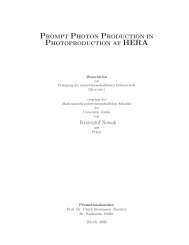Master Thesis Effect of vortex shaking on the ... - Physik-Institut
Master Thesis Effect of vortex shaking on the ... - Physik-Institut
Master Thesis Effect of vortex shaking on the ... - Physik-Institut
You also want an ePaper? Increase the reach of your titles
YUMPU automatically turns print PDFs into web optimized ePapers that Google loves.
some problems in finding an appropriate gain and had to switch it several<br />
times during <strong>on</strong>e run, leading to unstable measuring results. As a few tests<br />
revealed, this could be fixed by just changing <strong>the</strong> parameters to (8/231/8),<br />
proving <strong>the</strong> frequency dependence <str<strong>on</strong>g>of</str<strong>on</strong>g> <strong>the</strong> resistance again. The gain was<br />
stable until roughly 300Hz and <strong>the</strong>n became more and more unstable. Now<br />
that we did not have a reference measurement for <strong>the</strong> sample in <strong>the</strong> natural<br />
disequilibrium state we needed to know what we where looking for in our<br />
measured curves. We would expect a relatively sharp drop <str<strong>on</strong>g>of</str<strong>on</strong>g> <strong>the</strong> resistance<br />
in <strong>the</strong> last third <str<strong>on</strong>g>of</str<strong>on</strong>g> <strong>the</strong> n<strong>on</strong>-zero resistance part <str<strong>on</strong>g>of</str<strong>on</strong>g> <strong>the</strong> superc<strong>on</strong>ducting phase,<br />
just below <strong>the</strong> melting transiti<strong>on</strong>, in c<strong>on</strong>trast to a smooth curve. But again,<br />
no feature <str<strong>on</strong>g>of</str<strong>on</strong>g> this kind could be seen, although <strong>the</strong> same set <str<strong>on</strong>g>of</str<strong>on</strong>g> measurements<br />
as with <strong>the</strong> previous measurements had been performed.<br />
3.5 A New Material...<br />
As it became obvious that <strong>the</strong> remaining time would not be sufficient to plan<br />
and c<strong>on</strong>duct a totally new setup to solve our problem with NdBCO, which<br />
would have involved a time c<strong>on</strong>suming modificati<strong>on</strong> <str<strong>on</strong>g>of</str<strong>on</strong>g> <strong>the</strong> chr<strong>on</strong>ically fully<br />
booked PPMS, we decided to try a similar task with a quite different material:<br />
LuNi 2 B 2 C, being an intermetallic compound (instead <str<strong>on</strong>g>of</str<strong>on</strong>g> a cuprate) <str<strong>on</strong>g>of</str<strong>on</strong>g> <strong>the</strong><br />
form Ln-Tr-B-C, where Ln is a lanthanide element (Y, Ho - Lu) and Tr a<br />
transiti<strong>on</strong> metal (Pd or Ni). It is a type-II superc<strong>on</strong>ductor with a transiti<strong>on</strong><br />
temperature <str<strong>on</strong>g>of</str<strong>on</strong>g> ≈ 16.6K. This compound is not layered as <strong>the</strong> copper oxides<br />
are, but instead shows a 3D-structure, as shown in figure 13.<br />
In LuNi 2 B 2 C, we were looking for a possible feature in <strong>the</strong> resistance<br />
just below T c , where peaks have seen in measurements <str<strong>on</strong>g>of</str<strong>on</strong>g> <strong>the</strong> specific heat<br />
by M. Reibelt, a Ph.D. Student <str<strong>on</strong>g>of</str<strong>on</strong>g> our group.<br />
The first tests were d<strong>on</strong>e with a two-wire measurement, just to find <strong>the</strong> right<br />
orientati<strong>on</strong> <str<strong>on</strong>g>of</str<strong>on</strong>g> <strong>the</strong> crystal with respect to <strong>the</strong> field, and <strong>the</strong> coil was again<br />
placed in series with <strong>the</strong> measuring current circuit. To my surprise <strong>the</strong>se<br />
measurements showed again resistance values that were negative, this time<br />
even with <strong>the</strong> two-wire method, and had a strange temperature dependence.<br />
To check <strong>the</strong>se results I switched from <strong>the</strong> AC Opti<strong>on</strong> to <strong>the</strong> Resistivity<br />
Opti<strong>on</strong> <str<strong>on</strong>g>of</str<strong>on</strong>g> <strong>the</strong> PPMS and repeated <strong>the</strong> measurements. Now <strong>the</strong> resistance<br />
values came out positive, but <strong>the</strong> temperature dependence was still not as<br />
it should be. Instead <str<strong>on</strong>g>of</str<strong>on</strong>g> a general decrease with falling temperature, <strong>the</strong> resistance<br />
was growing heavily down to T c , <strong>the</strong>n dropped sharply for a while,<br />
and began <strong>the</strong>n to rise again. At higher magnetic fields <strong>the</strong> transiti<strong>on</strong> could<br />
not even be found until 3K. But this time we had several pieces <str<strong>on</strong>g>of</str<strong>on</strong>g> <strong>the</strong> same<br />
crystal at our disposal, so I took ano<strong>the</strong>r <strong>on</strong>e with a different surface and<br />
surface orientati<strong>on</strong> and made it ready for a four-wire measurement, to make<br />
19
















